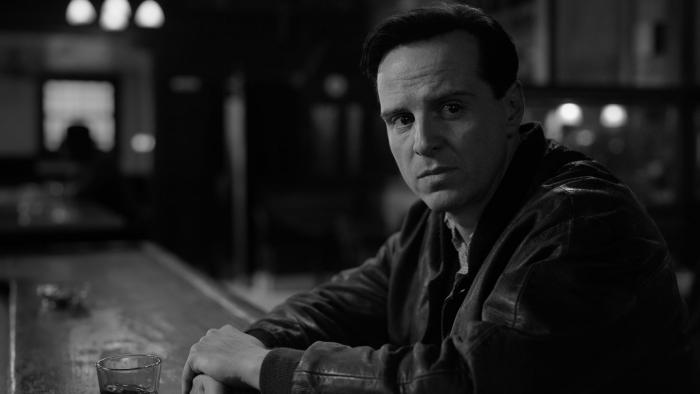

‘Ripley’ Is What 'Saltburn' Wished To Be
By Chris Revelle | TV | April 16, 2024 |
By Chris Revelle | TV | April 16, 2024 |

The “psycho queer” is an old trope that we’ve all seen before in television and film. Whether that be in animation, like with Powerpuff Girls’ HIM or Disney villains like Scar, Jafar, and Ursula, that are more classic turns of queer-coded villainy or recent live-action examples like Dahlmer, Swarm, or Saltburn that attempt more modern invocations, the “psycho queer” is an enduring archetype we continue to see in media today. As with many tropes, the value of the “psycho queer” rests in how it’s used. When deployed well, you get an anti-villain whose psychosis and danger come from mistreatment and denial; they are monstrous as a result of how society has ignored and/or smothered them with a rage born of wounds they need not have suffered if it were not for the community’s failure to accept them. When deployed poorly, the “psycho queer” is a much more shallow construction that conflates queerness with a demonic sense of wildness, as if heteronormativity exists as walls that protect us and to venture beyond them invites a madness that will twist human beings into sex monsters bent on the destruction of all that heteros hold dear. For a good example of just how wrong this trope can go, check out Gene Simmons in the very 80s spy thriller Never Too Young To Die:
It’s a somewhat revealing conception of lust that seems to hold that the only real difference between a cis-het and a queer is the ability to resist, contain, and bury that lust that would otherwise make everyone queer. The trope done poorly, it’s not that these characters are villains and queer, they’re villains because they’re queer and so their entire presentation is a hypersexual assault on the good people of society. It’s interesting to see this trope be re-approached more recently and for me, Saltburn is a particularly salient example with its blend of Brideshead Revisited and one of the most famous “psycho queer” stories of all time, The Talented Mr. Ripley. Now that Netflix has released a new series adaptation of the famous story entitled Ripley, I want to compare these two modern invocations of the “psycho queer” and see what we find.
Saltburn and The Talented Mr. Ripley both operate with the same broad strokes: a queer-coded man uses intricate lies and chicanery to become close to a rich handsome man they’re attracted to for both their beauty and their money. In both, the queer-coded man falls in love with the wealthy lifestyle and the feeling of belonging, to the point that they will kill even the man they love to maintain their access to it.
Saltburn’s point of view recognizes that queerness has shades of taboo and transgression attached to them, but is incurious as to why and takes these values as rote and self-evident. When coupled with the movie’s emphasis on explosive moments and aesthetics, this creates a dynamic in which queerness is conflated with transgression so that they are one and the same. This is bared out by how Oliver’s queer sexual escapades are framed; slurping down cum-diluted bath-water, humping a fresh grave, coercing Farley into sexual activity; these are pretty dark, predatory, and obsessive acts that paint a kind of grody picture as the film’s only queer sexual content. Saltburn confuses and mushes together so many lenses that it might’ve lost track of what it was doing, but for a story marketed so heavily as queer content, it certainly has a retrograde view of queerness as inherently aberrant or wicked.
That the film’s tone emphasizes Oliver’s queerness as salacious and wild feels nearly Victorian, a strange fit for a plot unfolding in 2006 and especially strange for a movie hyped up as daring and beyond-bounds sexual. In fact, all the sex we see, queer and otherwise, is coded as off-kilter and when you know the ending, that all of this was one long elaborate con to take the house and fortune, you’re left wondering whether Oliver wasn’t asexual and was so maniacally fixated on the money that there was no end of discomfort or empty sex he’d have to get it. However, if that’s the case, then what do moments like the bath water and the grave-humping amount to? Trailer bait? This is where Saltburn’s reach exceeds its grasp: it wishes to invoke the sort of psycho queer you can’t help but root for but struggles to manifest that beyond moments designed for shock that fail to manifest a consistent character. All of this adds up to an experience where Saltburn is to The Talented Mr. Ripley as Halotop is to ice cream.
On the other hand, we have Ripley, a series adaptation of The Talented Mr. Ripley, that offers a deeper and more textured portrayal that’s no less stylish. Shot in a silky, sensuous black-and-white pallet, Ripley makes several different choices that use the “psycho queer” trope much more elegantly. Tom Ripley’s queerness is framed as entirely natural and normal but challenged by a hostile time period with no tolerance to spare for him. We see this in moments like when Dickie catches Tom watching a group of men laugh and play on an Italian beach; Dickie suspiciously prods Tom about it and Tom defends the human pyramid the men are forming as impressive regardless of sexuality. These fleeting moments when Tom is allowed to connect to his queerness are framed as precious and rare times when he can drop his facade and breathe. These moments are important reminders to the viewer that underneath his composed mask, Tom is a human being. On Ripley, it’s not Tom’s queerness that twists him, but the alienation he suffers and the otherness he’s made to feel. The series recognizes a simple but powerful truth: queerness and the stigma attached to it are separate things. Tom isn’t a psycho because he’s queer; he’s a psycho because of society’s alienation of queerness.
Another important, simple thing Ripley recognizes is that the “psycho queer” is still human. There’s a sort of glittery, mythical dehumanization applied to marginalized groups that ostensibly praises but, in function, flattens their subjects into two-dimensional objects. Oliver, as seen in Saltburn, is an emotionless terminator whose queerness exists as a grotesquery to give his villainy some flavor and lacks compelling motivation for all his chicanery beyond “wants to be richer.” The film’s attempt to tie this to some “eat the rich” sentiment is undermined by his goal to simply become the rich. Ripley, on the other hand, emphasizes Tom’s humanity at every turn of the plot. He makes embarrassing mistakes, he’s awkward, he can be sloppy. Sometimes Tom lies well, sometimes poorly. Tom’s imperfections and his moments of connection, to the men on the beach, to Dickie, remind the viewer that as deceitful, chilling, and manipulative as Tom is, he’s still a human being.
Saltburn is too besotted with the splashy, so-naughty aspects of the “psycho queer” to remember the protagonist is still a human, while Ripely won’t ever let you forget. Saltburn and Ripley show how delicate the “psycho queer” trope can be and how important it is to put your characters’ humanity first.
← HBO's Remarkable 'The Sympathizer' Is Disorienting for a Reason | 'Fallout' Wants to Start a Flame in Your Heart →

Drew Barrymore Wanted To 'Break The Chain' Of Barrymore Alcohol Abuse
Rob Schneider Was Kicked Off Stage By Republicans
Keanu Reeves Lands Coveted Hedgehog Role
Hannah Waddingham Calls Out Photographer For Telling Her To 'Show Leg'
'Davey & Jonesie's Locker' Tackles The Difficulties Of High School Through The Multiverse
Megan Fox Breaks Her Silence on Chelsea Blackwell’s ‘Love Is Blind’ Resemblance Comment Controversy
More Like This
How 'Dune 2' and 'Shōgun' Handle the White Savior
Video Games Are Art and That's Okay
Nu Metal Can't Be Back Because It Never Left
Queerness Is a Gift
The Norman Lear Center Released A Report About Hollywood Gun Violence
Reviews